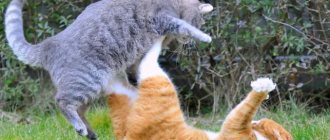Cats 42946
Childbirth is quite stressful for cats, as it is for absolutely any woman giving birth. Often, cat psychology, already poorly understood by people, changes significantly after the birth of offspring. You can often observe how a pet bites its babies, hits them with its hind legs or drags them by the scruff of the neck, while the kittens squeak.
The owners, alarmed by this behavior of their pet, begin to sound the alarm. However, not every mother cat nibbling on her litter is a danger signal. In this article we will try to understand when the behavior of a new mother is within the normal range, and when it is worth worrying about.
Bites as a method of raising offspring
A cat who has become a mother faces a difficult task: she needs to teach her litter everything she knows in the shortest possible time. This is required so that the kittens are ready for independent living. Moreover, in the wild, such activities would ensure their survival. At the same time, cats have much less time at their disposal than people have to raise their children.
You don't have to worry if your pet bites the kittens without leaving marks on their skins. As a rule, educational biting lasts until the baby makes a loud cry. With his voice, he lets his mother know that he understands everything, and, satisfied with this signal, she lets him go.
Biting means educating
New cat mothers immediately after giving birth are faced with a rather difficult and serious task. In a very short time, they need to teach their kids everything that they themselves can do. This is necessary primarily so that the kittens can live independently in the future. After all, in animals the survival instinct is much more developed, and, therefore, the acquired skills will allow them to live in any conditions.
There is no cause for concern if a cat bites her kittens lightly without leaving any painful marks on their skin. Most often, cats bite their offspring until the kitten makes a loud squeak. After this, the cat, as a rule, lets the baby go, taking into account that he has understood the lesson.
how to make friends between an adult cat and a kitten
Calm down or protect from danger
The psychology of the cat family is radically different from that of humans, and yet, in some ways we are similar. These animals, just like people, have their own methods of raising and protecting babies from danger.
Where a human mother would slap a naughty fidget on the butt, a cat mother will in the same way tell her baby how not to behave by biting the scruff of the neck. She can punish the kitten if it gets too excited and runs around, ceasing to notice everything around it. And also if the baby, being in a playful mood, climbs up to her, and in the meantime she tries to take a nap and replenish her strength.
A cat is capable of biting the skin of kittens that are trying to get out of the nest if she thinks that it is too early for them to do this. She will definitely claw her by the scruff of the neck or even hiss threateningly, not letting her onto the balcony, which, in her opinion, can be dangerous for furry fidgets.
You don’t have to worry if you notice how the mother stands over the baby and then takes his scruff in her mouth, then lets go. There is a high probability that at this moment she is not trying to harm him, but, on the contrary, wants to move him to a safe place. She just can't do it for some reason. Probably, the pet cannot figure out how best to lift it so as not to harm it. This sometimes happens, however, after several attempts, as a rule, the cat copes with the task.
The Art of Hunting
Don’t let it come as a surprise to you when your pet begins to teach her offspring to hunt. At the beginning of classes it will look something like this: the mother cat firmly grabs the kitten with her front paws and beats on him with her hind paws. At the same time, she alternates between biting and licking him. In addition, it can purr loudly, encouraging it to learn.
At the initial stage of training in the art of hunting, the cat demonstrates with its kittens how to properly capture and subdue the prey. In addition, the ability to suppress will be needed by the young when they grow up and begin to defend their rights to territory and dominance. And believe me, in a couple of weeks you will already be watching kids practicing these techniques on each other.
When the litter grows a little more and begins to crawl out of the shelter, a slightly different picture will open before you. In addition to the training activities described above, demonstration hunting jumps and pursuit will be added. Mommy, by personal example, will show the children how to sneak, wait and suddenly jump on the victim. Everything will remain the same with the squeak: if you meow, you understand. As before, the young animals will continue to practice the techniques both among themselves and on the mother.
An adult cat attacks a kitten. What to do?
Help me please. I have a rather difficult situation with my pets. A Persian cat, Marisha (13 years old), and an Alabai cat, also a girl (10 years old), have been living together in a country house for many years.
My cat is not neutered and has never been castrated, she has a very complex character, she doesn’t listen when you call her, she won’t give in to your arms, but at the same time she is affectionate and loves to sleep next to me. Cats came running to her site, but she did not let them near her. He behaves very aggressively towards other people's cats.
And some time ago a young cat came running to us (we assume he is not even a year old yet) and we decided to keep him. The cat is very affectionate and tame. Now the following is happening: Marisha attacks the new cat and does not let him into the house or even onto her half of the property.
I personally punished her for attacking him, but this punishment did not lead to anything, she continues to provoke fights. The dog doesn't pay any attention to them. Tell me, please, what should I do? How can you show Marisha that this cat is yours? After all, winter is coming and I’m going to move the new cat into the house (now he lives in the gazebo).
Sincerely, Veronika Kutsenko
Good afternoon I want to say right away that you are faced with a difficult task. Your adult cat is used to living in the house alone and feeling like a full-fledged mistress in it, but you want to convince her that the new pet also has the right to freely walk around her territory.
However, if you are firm in your desire to make friends with your pets, please have a lot of patience, the process will be long. Your task will be to accustom the animals to each other gradually, in small steps. If possible, first place them in adjacent rooms and separate them with some kind of translucent partition or mesh - so that the animals can see each other, smell the neighbor, but at the same time they cannot fight.
They need time to adapt. They must have separate bowls and litter trays. You can periodically change their places. Marisha must understand and realize that the new cat now also lives in this house as a member of the family, and the newcomer must get used to it.
At the same time, under no circumstances show greater affection for any of the animals; show equal care and attention towards them. The day will come when, under supervision, you will be able to remove the partition between the cats, and after some time, when you are sure that they are not trying to sort things out, you can gradually leave them alone.
But under no circumstances should you show aggression towards your adult cat, since by doing this you achieve the exact opposite of what you want: Marisha associates the new tenant with receiving punishment and her own discomfort, and this makes her even more angry with the cat.
You can ask your questions to Dmitry Kuklachev about the health, training and education of animals at: [email protected]
Rejection of foreign odor
In the case where a cat bites its offspring, and at the same time was previously picked up on the street or has access there for walks, this is a very bad sign. The fact is that such animals always remain semi-wild and their natural instincts are more acute than those of fully domesticated pets. Here, the reason for aggression towards one’s own offspring can be a foreign smell on the kittens. Unlike people, who recognize others visually, animals are identified using smell. Do not touch the kittens while the mother cat is nursing them, otherwise she may abandon them completely.
Other reasons
In addition to natural instincts and the educational process, there are other explanations why a cat bites its kittens:
- In order to stimulate their physical activity. Young animals must quickly build muscle mass, and for this, kids must move actively.
- The cat is unhappy with the nest, it is too hot, or it is located in a noisy place.
- The onset of heat. In this case, the female is aggressive towards the offspring and can bite her cubs.
- Foreign odors from kittens. Babies should not be touched with hands, as cats communicate using their sense of smell, and other people's smells can cause inappropriate behavior in the mother.
- Genetic abnormalities or hidden pathologies in kittens. Cats instinctively sense disturbances in the development of their young and can, by biting, check the viability of the offspring or try to get rid of them.
There are many reasons why a cat bites her kittens - from the manifestation of natural instincts to a serious illness. The owner of the animal must observe and control the behavior of his pet. If educational techniques are playful and do not cause harm or injury, then such behavior should not cause concern. In case of aggression or injuries, it is better to consult a veterinarian. The kittens may have to be separated from their mother earlier than planned.
Similar articles
- Why cats eat their kittens
Why does a cat bite her kittens | Other reasons. A cat gave birth to dead kittens: what should owners do? When can you take a kitten away from a cat? Read more - How to punish a cat, is it possible and how to do it correctly...
A cat can tear off new wallpaper, ignore its toilet, and bite the legs of household members and guests. ... Why do cats carry dead animals home, why... Why does a cat take kittens to another place. Read more
- Why do cats purr and purr, what sounds do cats make...
Reasons why cats purr. The fluffy beauty is associated with comfort, warmth and, of course, with... The relationship between a mother cat and a kitten. This vibrating dialogue is typical for determining the health status of children. Read more
- Why do cats crush people with their paws, why do cats...
Why does a cat rub against the legs of people, the owner, what does it mean... How to understand that a cat has given birth to all kittens. Why does a cat bite when you stroke it, does the cat lick... Origin of cats: history of the species, from whom, where... Read more
- Why does a cat bite when you pet it, the cat licks...
Why does a cat bite its kittens? How to stop a cat from tearing up wallpaper and furniture, what to do if... How to train a cat, conduct training at home... Read more
Disease
There are times when a pet suddenly begins to show excessive aggression both towards its own babies and towards its owners. It is not uncommon for cats to develop eclampsia after giving birth, and this can be a reason for sudden hostility.
Eclampsia is a disease that should only be diagnosed by a specialist. It is not recommended to make a diagnosis yourself, because the cause of aggressive behavior may be simple fatigue or pain in the mammary glands (mastopathy). And yet, given that this disease occurs quite often, let's talk about it in more detail.
Why is a cat aggressive towards her adult kitten and how to make them friends?
QUESTION:
After the last lambing, they left the cat for themselves, now there are two cats in the apartment - a mother and a daughter, but after she finished feeding, the young one became a stranger to her.
They are at enmity, or rather, the mother cat is aggressive towards the young one, hissing and even spreading her paws. They decided to sterilize the eldest one - she is 7 years old, and left the young one for further production of kittens. How can they be reconciled? And when the kittens appear, how will the grandma cat perceive the newborns? Thanks for the answer! ANSWER:
First of all, you need to decide how serious the conflict is. The fact is that cat games can be very loud and very similar to real battles. The combatants raise their fur, intertwine in embraces, somersault and roll on the floor - however, there is no real aggression or injury. It has been noticed that most of the techniques “rivals” are practiced “with gloves”, without using their claws. After a fight, cats quickly change their anger to mercy and subsequently exist quite peacefully, showing elements of attention and goodwill (mutual licking and rubbing their cheeks, sleeping side by side, eating in close proximity to each other).
Often a hiss, a raised scruff and a strike with a clawed paw are just an expression of a sudden surge of emotion. The animal may have felt irritation or physical discomfort. Group members use this technique to restore the status quo, and an outbreak of aggression does not at all mean a “declaration of war.” It has been noted that quite harsh disputes occur between littermate kittens, but with a significant difference in age, the older animal usually occupies a higher status, supporting it with a demonstration of dominance. There is nothing terrible that a mother periodically “raises” her grown-up daughter, who is entering the phase of puberty - their warm relationship is not broken, but is illustrated by trivial “family scenes.”
The true intensity of the hostility is evidenced by repeated scenes:
- long howls and screams;
- low, angry growls and hisses;
- static “stone” poses;
- ears laid back and pressed to the head;
- looking eye to eye;
- claws extended and readiness to use them;
- raised wool;
- swollen, nervously wriggling tail.
Usually, after a psychological attack, the subordinate individual “loses his nerves” and retreats from the “battlefield.” But rivals of equal strength do not want to give in and, along with intimidation techniques, use alternating pounces and paw strikes. The rash intervention of a frightened owner at such a moment (for example, an attempt to pick up one of the fighters in his arms or push him away with his foot) can “add fuel to the fire”, switching aggression to the person. Need I remind you that “there is no beast worse than a cat,” and an angry cat can cause serious damage in the heat of passion.
The culmination of the confrontation is “close combat”, in which the participants cling together into a single ball using claws and teeth. Shreds of fur flying in all directions, screams and growls add poignancy to the picture.
You can break up such a brutal cat fight using some strong irritant that switches the attention of the animals, for example:
- clap hands;
- the sound of a saucepan lid falling on the floor;
- a sharp shout;
- pouring cold water on the fighters.
Experts advise using another specific trick: you need to throw a blanket or thick blanket over the mating cats, pressing it along the perimeter to the floor, and hold it until the bullies disperse on their own, instinctively clinging to the floor. Next, one of the participants in the battle can be picked up and carried to another room.
Murkas fight for various reasons, but the fights are based on instincts:
- defensive (personal comfort);
- territorial (fight for territory);
- prey (competition for food and other resources);
- sexual (defending the right to have offspring and ensuring their safety);
- social (some kind of “jealousy” towards the owner).
Thus, cats can fight without sharing:
- territory;
- shelters;
- food and toys;
- owner's attention.
In same-sex individuals kept in the same house, “passions” are fueled by sexual cycles.
To level out the conflict and allow both “warring sides” to become more tolerant, felinologists suggest the following actions:
- divide the territory of the house, laying out “its own route” for each pet. Thus, a less aggressive cat can move along the upper tier, for which purpose all kinds of shelves, hammocks, stairs and passages are hung on the walls. Thus, a direct clash “on the warpath” will be excluded. As relations warm up, some of the structures can be removed;
- install at least two trays, houses, beds and scratching posts in different places, which will reduce competition for resources;
- feed cats at the same time, but in different places: for example, one from a bowl on the windowsill, and the other from a bowl on the floor. At the same time, it is important to ensure that the dominant mother does not try to take food from the younger cat;
- pay attention to pets without singling out personalities, trying to stroke or treat both cats with treats from the fingers at once;
- do not ignore the attempts of tailed pets to escalate the conflict, instantly scattering them in different directions;
- for severe anxiety, use sedatives and anti-stress medications (Cat Bayun, Stop Stress, catnip powder).
Steilization leads to a decrease in the level of sex hormones and often to an automatic decrease in the personal status of the animal. After surgery, the cat becomes less frisky and emotional, which will most likely reduce its bullying behavior.
It is impossible to predict the attitude towards future kittens born by a cat-daughter: with a developed maternal instinct, the “grandmother” will treat her “grandchildren” with love and care, helping her daughter cope with her offspring. But a less successful scenario is also possible, when the older animal perceives newborns as increased pressure. Some lovers of mustachioed tabby cats write that as the second individual grows up, the slaughter intensifies and one of the cats has to be handed over to “good hands.”
Tweet
Eclampsia in a cat: what are the signs and what to do?
Eclampsia (aka milk fever) is provoked by hypocalcemia - a disorder of calcium metabolism in the body, in which it begins to be sorely lacking. Milk fever usually develops in the first 2–3 weeks after lambing. This is due to the active leaching of calcium from the blood, due to the fact that it is involved in the formation of milk. Most common in mothers with multiple births.
Behavioral signals of developing eclampsia:
- Increased excitability and anxiety or lethargy and complete apathy;
- Aggression accompanied by lack of recognition of offspring and owners;
- Refusal to sit with own kittens;
- Avoidance of droppings feeding and biting, leaving marks on their skins;
- Frequently moving babies from place to place.
Physical signs of milk fever:
- Pointed muzzle with stretched skin and exposed fangs;
- Rapid breathing;
- Pale mucous membranes;
- Movements become abrupt;
- The animal has difficulty rearranging its “stiff” hind legs due to muscle spasms;
- Convulsions (intensity depends on the severity of the disease);
- Increased body temperature;
- Shiver;
- The pet often falls on its side;
- Uncontrollable salivation appears.
In a cat with eclampsia, the temperature rises to +41 °C. Carbon dioxide accumulates in the body, making it difficult for the animal to breathe. The pH in the blood increases and the calcium level decreases.
Milk fever is not so much dangerous for others as it is for a sick pet. If help is not provided in time, death from hyperthermia - due to depressed breathing and brain damage - will occur 12 hours after the onset of the attack.
If your pet has an acute attack of eclampsia, call your veterinarian immediately. Sometimes time passes by minutes, especially when an attack is not detected immediately, the doctor may simply not have time. It is in this case that, while waiting for the doctor, you will need to provide first aid to your pet yourself.
In case of an acute attack of eclampsia, it is necessary to inject subcutaneously:
- Fospasim or any other sedative - 1 ml;
- Gamavit - 1 ml;
- Calcium borgluconate (heated to 39°) - 2-3 ml at intervals of 45 minutes until symptoms disappear;
- No-shpa - 0.3 ml;
- Prednisolone - 0.5 ml.
After injections, place the cat in a dark, noise-free room until the attack stops. To prevent relapse, calcium (1 ml) will need to be injected 2 times a day for about two more weeks.
As the disease progresses, the kittens are taken from the mother cat and fed with an artificial formula, then returned. If the babies are more than 3 weeks old, introduce complementary foods; formula alone will no longer be enough for them.
Certain cats are more prone to milk fever than others. If your pet is predisposed to eclampsia - if such an attack has occurred at least once - it is necessary to pay special attention to her after lambing. In addition, it is worth worrying about the issue of prevention in advance by consulting with a veterinarian. As a rule, a diet with a high calcium content is prescribed. Cats at risk always have a fairly high chance of relapse. For such pets, the intervals between lambings should be as long as possible.
Bites as a health check and detection of weak litters
A cat bites kittens not only when raising them or in an attack of some disease. Remember the main law of animals: “survival of the fittest”? So, animals, unlike people, do not care for young animals with congenital diseases; on the contrary, they can behave very aggressively towards sick litters.
Cats, although domesticated, still have innate instincts that they cannot escape. Sick kittens will be detected by the pet just by biting. As already mentioned, by biting lightly, the cat checks the reflexes of the offspring, and if something does not suit her, she will abandon the sick baby. Be careful, there is a high probability that the mother will try to kill the baby who is unfit for life.
If you notice that one of the kittens stands out from the general heap of brothers or the mother cat is more aggressive towards one of them than towards the rest of the litter - sound the alarm, the kitten is sick. If you are going to keep him alive, take him to the vet. As a rule, after the sick baby is cured, the cat accepts him back and no longer shows hostility towards him.
It is better not to wait for your pet to attack the kittens, but to periodically examine them yourself, showing them to the doctor if necessary. The health status of furry babies can be determined “with the naked eye” by a number of signs.
Healthy kitten:
- It looks round and knocked down;
- Skin pink;
- Warm to the touch;
- If you gather the skin into a fold and let it go, it will straighten out immediately;
- On the palm of your hand, the baby stretches out and swings energetically.
Sick kitten:
- Lack of energy, barely moves, constantly lethargic;
- Hyperactive, but exhausted, falls asleep away from his brothers and mother;
- He sleeps with his limbs spread to the sides, his head tilted to the side;
- Noticeably cool to the touch;
- Skin has a bluish tint;
- When trying to eat, the nipple spits out;
- While awake, he continuously screams pitifully.
If, according to your observations, all the kittens are healthy, but the cat still shows obvious aggression towards one (or several) of them, she probably does not have enough milk. She may try to compensate for the lack of milk by weaning someone off the breast so that others can get enough. As a rule, the weakest descendant, even if not the sick one, is selected for this purpose.
Video: cat raising kitten
A cat bites its kittens - reasons
3756Administration
Cat instincts oblige you to educate your offspring from infancy. Often, owners can observe that the pet begins to drag the children by the scruff of the neck, hit them with their paws, and even bite them. And this behavior raises concerns about why a cat bites its kittens. What is considered normal, and what serves as an alarm bell?
Kittens grow quickly and therefore the mother cat has little time left to instill in her offspring all the basic life skills. If this is not so urgently necessary for domestic animals, then for street animals it is a matter of survival.
© shutterstock
There is no need to worry if the cat bites and thereby does not injure the kittens; this is only a method to rein in a naughty baby. As a result, he squeaks and makes it clear that he understands.
What does a cat teach its offspring?
- Hunt . This instinct remains from the times when in nature cats had to get food. Therefore, the cat teaches the art of survival, which can help in conquering its territory. During training, she can bite a kitten, showing how to properly suppress the victim. Then they themselves will practice this on each other. The cat will teach the grown kittens to attack prey from a hiding place.
- Protect from danger or stop the game . Until a certain point, the cat does not let the kittens out of a secluded place where they are safe. Therefore, all attempts to leave him can be stopped by a bite on the scruff of the neck. She often bites the kitten in order to grab it and drag it to another place. The cat may bite the baby several times to choose the correct and safe point, and then carefully pick it up and carry it away. The pet also bites angry kids who are too carried away by the game. By analogy with a person, this is a slap to a fidget.
- Toilet train . Some especially clean furry mothers can pass on to their kittens the ability to relieve themselves in a certain place. This happens already at the stage when the young animals are old enough to understand what is wanted from them. And those who refuse to learn are sometimes bitten or hit by the cat with its paw.
© shutterstock
When should you be concerned if your cat bites your kittens?
Sometimes bites become a sign of a cat's aggression towards its offspring. It is easy to recognize if you watch the progress of learning or playing. Usually the mother bites, but controls her actions, takes care of the babies, even after biting, she licks them. But not all cats behave this way. Stress caused by childbirth or personality traits can influence aggressive behavior. Then she bites the kittens, leaving marks, hisses, and can hit them hard with her paw.
The second common factor in the development of hostility towards kittens can be a disease called eclampsia, pain in the mammary glands caused by feline mastopathy, or simple fatigue. It is not recommended to make a diagnosis yourself; entrust this to a veterinarian. He will prescribe the correct treatment that will benefit the pet and its offspring.
Let us dwell in more detail on such an unpleasant disease for a cat when she bites her kittens, such as eclampsia. It occurs due to calcium leaching and can appear 2-3 weeks after birth. The disease can be recognized by the behavior and appearance of the pet. Signs will include the following symptoms:
- lethargy or increased excitability,
- pronounced signs of aggression towards the owner and offspring, the cat may bite kittens, leave and be absent for a long time,
- mucous membranes turn pale, breathing becomes rapid,
- Limb spasms and convulsions may occur,
- There is profuse salivation, increased body temperature, and trembling.
Eclampsia, called milk fever, is a dangerous disease for cats. Therefore, you need to notice the symptoms as early as possible and consult a doctor. An increase in body temperature to extreme levels and respiratory depression as a consequence of an attack can cause the death of the animal.
© shutterstock
An acute attack of eclampsia should be an alarming signal to urgently call a veterinarian. The owner and the doctor may have too little time to provide assistance and save the cat’s life.
Cat bites to test health conditions to identify weak kittens
Noticing how a pet bites its children, you can remember the law of nature that says that the fittest survives. Often a cat bites kittens not only for educational purposes, but also to identify children with congenital pathologies. Animals are aggressive towards such individuals.
The survival instinct does not allow the cat to leave the sick kitten; she will probably abandon him . She identifies sick individuals by biting each one and looking at the reaction. Be careful if any kitten is left without attention or if you notice obvious aggression towards it on the part of the mother. She will probably want to get rid of the patient. Show him to the veterinarian, perhaps all is not lost and after treatment the cat will accept the baby again.
How to distinguish a sick kitten from a healthy one
Take each kitten in your arms and carefully examine it; it is quite easy to distinguish an unhealthy one. Healthy kitten :
- plump, with a round belly,
- the skin is pink in color, easily smoothed out if folded and released,
- warm and stretches out on the palm.
© shutterstock
Sick baby:
- very lethargic and can barely move or, on the contrary, is too active, but does not have enough energy for long and collapses from fatigue,
- skin is bluish, cool,
- constantly squeaks pitifully.
The kittens may all be healthy, but the cat aggressively bites one or more. Perhaps she has little milk and this is a way to feed at least part of the offspring. Then caring for the younger generation should fall on the owner. All that remains is to feed the babies with milk from a pipette or syringe without a needle.
You don't always need to sound the alarm when cats bite. If they do not harm the kittens, then this may just be a learning phase. Serious behavioral abnormalities require observation and consultation with a veterinarian. Aggression when she bites kittens is unacceptable. Show more attention if the cat has become a mother for the first time, help her survive stress, and she will become caring and attentive to her babies.
IMPORTANT!
VETERINARIAN CONSULTATION REQUIRED. INFORMATION FOR INFORMATION ONLY. Administration
Share with friends
Article rating











